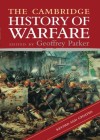The Cambridge History of Warfare
Edited by: Geoffrey Parker,
New York, Cambridge University Press, 2005,
ISBN: 9780521618953, 432pp.
Reviewed by: Anthony Robinson, FDI Associate, Canberra
With every major conflict, there is a temporary period when titles that focus on war and conflict move from the back of the bookstore to the front. Many of these works, while valuable by themselves, often look at one conflict and sometimes one battle without considering the evolution of warfare. Placing individual conflicts in the context of millennia of human competition, such as The Cambridge History or Warfare, provides for a richer understanding of contemporary, and perhaps future, conflicts.
The Cambridge History or Warfare is written in an accessible style and fills the void between earnest, academic theoretical works and superficial approaches that do not satisfy the more discerning student of history. It provides a good reference source for history students, from undergraduate through to those undertaking postgraduate studies. In addition, casual readers, seeking a good read and or an A-to-Z about warfare, strategy and history, will find the book enjoyable and a useful addition to any reference library.
The editor and contributing author, Geoffrey Parker, is a Professor of History at the Ohio State University and has written or edited more than thirty books. His latest work is the result of collaboration with six other contributors. These contributors include Williamson Murray and the distinguished and much published US scholar Victor Davis Hanson, another aficionado of the Western way of war. The result has been carefully collated to produce the answer to the question: how did the ‘Western way of war’ become so dominant? The editor puts forward the proposition that the ‘Western way of war’ rests upon five foundations: technology, discipline, an aggressive military tradition, an extraordinary capacity to respond rapidly to challenges, and the use of capital rather than manpower to achieve victory. The combination of these factors has ensured Western predominance over the ages. Although the work takes an unashamedly Eurocentric view of warfare, it acknowledges the military effectiveness of adversaries.
In the introduction of the book, the editor makes the claim that ‘Religious and ideological constraints have seldom interfered with either the discussion or the conduct of war in the West’. St Augustine may disagree. ‘Who pays and why’ is as important in the western way of war as ‘Who fights and why’. It is the ability to organise long-term credit, and therefore the existence of a secure and sophisticated capital market, to fund public borrowing in wartime which represented a crucial ‘secret weapon’ of the West.1
The work covers five eras, ‘the age of massed infantry’ from 600 BCE to 300 AD, ‘the age of fortifications’ from 300 AD to 1500 AD, ‘the age of guns and sails’ from 1500 to 1815, and the last section covers ‘the age of mechanised warfare’, from 1815 to 2004. The second chapter, titled ‘From Phalanx to Legion’, superbly written by Victor Davis Hanson, provides a fascinating dissertation on the ‘Revolution in Military Affairs (RMA)’ brought about by Rome. This RMA radically changed the structure and subsequent lethality of 2nd-century BCE warfare. Hanson describes this change as the: ‘... Roman way of war thus stood in stark contrast to the chaos of the Hellenic military style ... mobility and fluidity, not naked force, and the short sword, not the pike, gave newfound lethality to Roman infantry.’2
However, the Roman way of war, as with all other ways, had its own weaknesses. Hanson describes how two specific and very different battlefield environments, the narrow flat terrain found at Cannae in 216 BCE and the open treeless plains of Carrhae, resulted in the annihilation of Roman fighting forces.
Overall, the work is balanced and presents an objective view of warfare and strategy throughout the ages. As such, the reviewer was perplexed to read the editor’s comparison of US President George W. Bush and Adolph Hitler in the epilogue:
In the 1930s only one European leader really wanted war: Adolph Hitler; in the first years of the twenty-first century, only one world leader really wanted war with Iraq: George W. Bush. In both cases, the war that most of the world desperately opposed broke out.3
Most historians and commentators agree that history has not yet decided on the wisdom or otherwise of US-led 2003 invasion of Iraq. The editor’s observation is a little premature to be incorporated into works of history, published less than three years after the event, with the outcome still in doubt.
In his concluding chapter, Parker summarises his formula for the future of the western way of warfare as:
The future of the western way of war, and son of the western way of life and the advantageous economic system that sustains it, ultimately depends on three things: a sustained ability to mange international crises and prevent them from turning into armed conflicts, the outcomes of which is always unpredictable; the continued willingness to pay (in both human and material terms) for defence against perils that are not immediately apparent; and the maintenance of each state’s political control over its armed forces ...4
In conclusion, the book is an admirable and informative read. It is fully referenced and has an excellent index and notes section. Several unfortunate typographical errors, including one on the first page, fail to disguise the significant effort put into producing this work of history.
Endnotes
1 Geoffrey Parker (ed.), The Cambridge History or Warfare, Cambridge University Press, 2005; p. 9.
2 Parker, p. 41.
3 Ibid, p. 429.
4 Ibid, p. 428.

